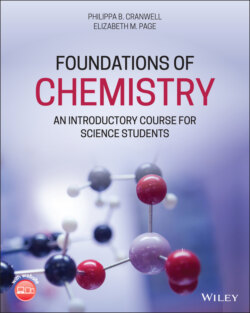Читать книгу Foundations of Chemistry - Philippa B. Cranwell - Страница 47
End‐of‐chapter questions
Оглавление1 Determine the derived units of the following quantities:Acceleration, a (a = change in velocity/time)Force, F (F = m × a, where m = mass and a = acceleration)Gravitational potential energy, PE (PE = m × g × h, where m = mass, g = acceleration due to gravity, and h = height)
2 Express the following numbers using scientific notation:0.0084984 2653540.0000218
3 Convert the following numbers to non‐exponential form:2.3 × 10−22.8 × 1024.95 × 10−45.759 × 105
4 Write the following quantities in a more convenient form by changing the units, and give the answer in scientific notation:6 300 m (change to km)1 540 ms (change to s)0.000456 kg (change to g)639 500 J (change to kJ)6 500 ns (change from ns to μs)250 cm3 (change to dm3)0.5 L (change to cm3)
5 How many significant figures are in each of the following numbers?0.094583.220106.00.00314
6 Determine the results of the following calculations, taking care to give the correct number of significant figures and units in the answers.12.786 cm + 1.23 m =3.21 cm × 150.091 mm =1.090 m divided by 10 s =2 100 J + 5.13 kJ + 6 MJ =
7 Determine the results of the following calculations, taking care to give the correct number of significant figures and units in the answers. Give your answer in scientific notation.3.2 × 103 m × 3.1 × 10−5 kg m−1 =9.47 × 10−3 km ÷ 2.3 × 10−1 m s−1 =30.6010 × 10−3 kg − 1.040 × 103 mg =
8 Using the information in Table 0.4, write the formulae of the following compounds:potassium nitratecalcium chloridesodium sulfateammonium phosphatealuminium sulfate
9 Balance the following equations by adding appropriate stoichiometric coefficients:N2 + H2 → NH3Fe + O2 → Fe2O3C5H12 + O2 → CO2 + H2ONaOH + H2SO4 → Na2SO4 + H2OLi + H2O → LiOH + H2
10 Write balanced chemical equations for the following reactions, including state symbols, assuming they are carried out at room temperature. Use Table 0.4 to obtain the formulae of the salts included.Hydrogen and oxygen to give waterGraphite (an allotrope of carbon) and oxygen to give carbon dioxideCalcium carbonate (a solid) with hydrochloric acid (an aqueous solution of HCl) to give calcium chloride (in aqueous solution), water, and carbon dioxideAn aqueous solution of silver nitrate with an aqueous solution of sodium chloride to give a precipitate of silver chloride and sodium nitrate in solutionThe thermal decomposition of solid lithium nitrate to solid lithium oxide, oxygen, and nitrogen dioxide (NO2) gas
